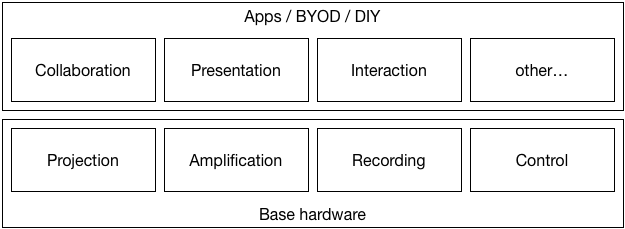Work
More focus on learning spaces, both for the new Taylor Institute building, and for a classroom renovation in Haskayne. Lots of interesting options for flexible use of space. We are looking at using hardware as the core platform within a space, with software adding the actual interaction stuff - that model makes it much easier to switch things around, without having to have monolithic devices and appliances that try to do everything. Small pieces, loosely joined.
Something like:

The exact brand name or application used for each function can be swapped out, and the rest of the pieces adapt to inherit whatever that piece brings with it.
Read
- Derek Bruff: Learning Spaces + Coordinate Axes + Placemark Questions - some really interesting stuff on learning spaces, from Vanderbilt.
- more great stuff from McGill's Teaching for Learning blog: Customizing the Content Module in myCourses
- Tony Hirst: So What Can Text Analysis Do for You? - text analysis beyond simple concordance
- algorithmically generated ocean waves in HTML, javascript and WebGL. Holy.
- MakeCalgary: A Digital Environment: A Day in the Life of a Student
- President Cannon on leading a university - I am extremely impressed at how the university has changed since Dr. Cannon started as president. This is a great overview of what's been happening.
- Michael Feldstein: Blueprint for a post-LMS, Part 4
- Campus Technology, linking to an article by BYU: Using Active Learning More Important than Flipping the Classroom - a really nice article, helping to cut through the nonsense fluffy hype about flipping stuff.
- which segues nicely into this article on flipped classrooms by Faculty Focus
- Life Sciences Education - the entire March 2015 issue is fantastic.
- Scott Dannemiller: Busy is a sickness (via link from Victoria Klassen )
Other
